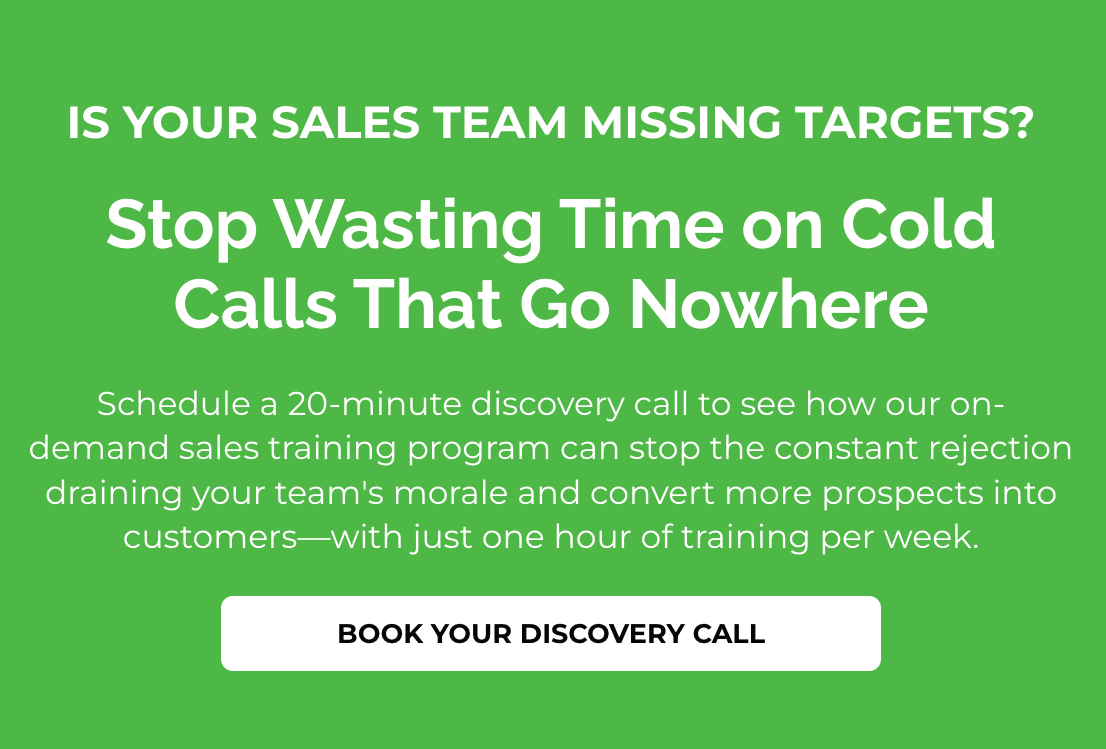The Cold Calling Script That Actually Works

Why Cold Calls Fail—And the Cold Calling Script That Actually Works
Most sales leaders think their reps have a cold calling problem.
The real issue?
It’s not call volume. It’s what reps say once someone actually answers.
Your top 1 or 2 reps follow a pattern.
Everyone else? They wing it, and your pipeline pays the price.
At SalesBuzz, we’ve reverse-engineered over 30 years of real-world selling into a step-by-step phone sales process your team can actually follow.
No gimmicks. No tricks. Just a script that works—because it’s built on how real sales conversations unfold.
🔍 Step 1: The Opening Value Statement (OVS)
This is where the call lives or dies.
You have 5–7 seconds to earn a response that’s not:
“We’re all set.”
It’s not about avoiding phrases like “How are you?”
That’s a false flag.
🔥 Most “sales gurus” knock that line because they don’t know what else to fix—so they attack the wrong thing.
The truth? “How are you?” works just fine if you sound confident and follow it with a strong, relevant reason for your call.
The real problem is reps who hesitate, sound unsure, or lead with fluff.
Instead, try this framework:
“Hi, this is [Rep Name] with [Company]. The reason for my call (PAUSE) there’s a strong chance [insert benefit you offer], so that [desired outcome].
And if I caught you at a good time, I’d like to ask a few quick questions to see if what we offer may be of some help to you. Would that be OK?”
Real-World Example:
“Hi, this is [Rep Name] with [Company]. The reason for my call (PAUSE) there’s a strong chance I can help you help your team follow a proven phone sales process, so that pipeline isn’t dependent on just your top 1 or 2 reps. And if I caught you at a good time, I’d like to ask a few quick questions to see if what we offer may be of some help to you. Would that be OK?”
Takeaway:
Open warm, sure. But lead with confidence and relevance.
Otherwise, the call’s over before it starts.
🧠 Step 2: Ask Engagement Questions That Trigger Real Conversations
Once you pique interest and gain permission, you’ve earned a short window of opportunity.
But most reps blow it.
They get past the opener… and then wing it.
They ask something vague.
The prospect’s tone drops.
The energy evaporates.
And the call’s dead in under 10 seconds.
Why?
Because no one taught them what to say next.
The Purpose of the Engagement Question
Your first question after gaining permission isn’t about qualification yet.
It’s about getting the prospect talking in a way that naturally leads to problem recognition.
This is the pivot point.
A great engagement question will:
✅ Shift the focus to an area of friction
✅ Get the prospect talking out loud about their situation
✅ Set you up to identify whether a real problem exists
If reps skip this and jump straight to things like:
“Are you the decision-maker?” or “What solution are you using now?”—they miss the opportunity to uncover pain.
And without pain, there’s no urgency to change.
What Makes a Great Engagement Question?
It does one thing above all:
It puts the prospect’s attention on an area you need them thinking about.
You’re not just making small talk.
You’re steering the conversation—without being pushy—toward a pain point that aligns with your solution.
To do this right, the question must:
✅ Focus on what matters to them (not you)
✅ Be easy to answer—no resistance
✅ Feel natural and conversational
✅ Work regardless of how they respond
Because once they answer—even briefly—you’re no longer cold calling.
You’re in a conversation.
And that’s where pipeline begins.
⚡️ Why This Works (and Your Current Cold Calling Script Doesn’t)
✔️ It’s not about memorizing lines—it’s about following a proven structure
✔️ It works on cold, warm, or inbound calls
✔️ It builds rep confidence, because they know what to say next
Your reps don’t need to be actors.
But they do need to stop winging it.
When you give them a structure they can trust, they show up more confident, and the pipeline reflects it.
What You’ve Just Seen Is Only the Beginning
Opening value statements and engagement questions are just Steps 1 and 2 of a full outbound sales system that continues through:
• Opportunity Size
• Problem Recognition
• Decision Role
• Time Frame
• Purchasing Power
• Presentation
• Objection Handling
• Closing
We cover every step in our 8-week, on-demand phone sales course.
Each lesson takes just one hour a week to complete—and your reps can access it anytime, from anywhere.
The Program Includes:
✅ Self-paced, online learning
✅ Quizzes and retention checks
✅ Manager dashboards to track progress
✅ Full-funnel phone sales training—from openers to close
🧵 Sales Leader Takeaway
If your team is:
• Burning through leads
• Sounding unsure once someone picks up
• Or getting shut down after the first 10 seconds…
This isn’t a people problem.
It’s a process problem.
And we’ve built the fix.
📞 Ready to See How It Works?
If you’ve got 3 reps or 300, and you’re tired of pipeline being carried by just a few standouts, this is for you.
Let’s talk.
No pressure. Just a quick conversation to see if we’re a fit.

